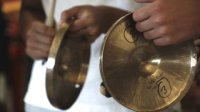The Social and Emotional Benefits of Being Weirdly Creative
The boy is small in stature, bespectacled, and unnaturally articulate for a sixth grader. I have heard from his teachers and principal at Annapolis, Maryland's Wiley H. Bates Middle School about the academic benefits of arts integration, how various forms of artistic expression (PDF) are employed to learn math and science as well as language arts. I have also learned about the virtues of a critical-thinking technique known as Artful Thinking, developed by Project Zero at the Harvard Graduate School of Education, that deepens students' intellectual understanding generally by deepening their understanding of the multiple layers of artistic expression.
Now I am keen to discover more about the social and emotional aspects of this learning strategy. Are relationships between students positively affected by arts integration? What about the rapport between kids and teachers? My young source holds forth with disarming confidence, especially about some of the toughest social and emotional issues middle school students face: fitting in with your peers, being different without becoming isolated, how to navigate the gauntlet of critics, teasers, and bullies that line the rocky path to high school.
I probe for more details. (Full disclosure: I, too, was a little guy, often defending myself against the big boys whenever they set out to prove their physical dominance. So I find my source's calm, rational discourse a bit too good to be true.) What I learn from him starts to soften me up.
I'll paraphrase his remarks: Expressing yourself creatively in front of an entire class, especially when you are not good at art, is the great equalizer. At first you feel pretty weird, especially singing and dancing. Because you've never done anything like this before, and you're not sure you want to work with other students this way. You think maybe someone will make fun of you. But because everybody has to sing and dance and do the art, everyone is in the same boat. It's harder to put someone down if you're the same as him.
(My source seems to relish this next part of his description.)
So you have to keep doing the art day after day. You have to dance the motions of the planets or sing their name in a song or take a photo of a jungle gym exhibiting the properties of an isosceles triangle. And somehow, through all these awkward displays of creativity, the social playing field levels, and you actually start to have fun, and you begin to make friends with kids you might never have even spoken to, because they're having fun, too.
Even Too-Cool-for-School Kids Can't Resist
I get the point, and I am impressed with his how-a-negative-becomes-a-positive analysis. Still, I want to see this contagious classroom creativity in the flesh. I am escorted to Mrs. Dunn's seventh-grade math class. Here students are investigating the geometric properties of circular shapes, in this case, the circular shapes of traditional Balinese percussion instruments. As round cymbals and drums of various sizes are distributed to the students, I size up the class. A not untypical cast of characters, all shapes, sizes, and colors. One group catches my eye: three boys wearing similar athletic-style jerseys. Tallish, physically fit, and chuckling with each other, they are clearly content with themselves. Asked by the teacher to observe something about the circular instruments, each obliges haltingly. Two of the three are only moderately helpful in group efforts to choreograph a dance to illustrate the circle properties. But when the entire class commences to play the instruments and dance around in concentric circles, I am astonished.
First of all, it's true: Everyone looks pretty weird, especially my boys in the jerseys. And it only gets weirder as the tempo picks up. Unexpectedly, I actually find myself choking up. Virtually every kid is smiling, if not laughing out loud. Heads, tails, and torsos are wagging in all directions. A blissful oneness seems to reign across all the social divides, and even the three musketeers seem dead ringers for the goofy, upbeat little preschoolers I am sure they once were. When asked after the dance about circular geometry, the quick, animated responses from every corner of the classroom leave no doubt that learning is happening.
Almost without exception, teachers at Bates are enthused about arts integration as a method for making learning a deeper experience for students and faculty. They are quick to add that the program has not brought an end to classroom disruptions, the need to keep kids on task, or the occasional disciplinary referral or suspension. But it has rolled back the need to police kids. And it has opened up new vistas of social and emotional connection between students and adults. As one science teacher reports, "With the vast majority of my students, I am truly facilitating big chunks of their learning by focusing them on diverse artistic expressions of their knowledge. They do the expressing, not me. And because I am not commanding them, I think they like me better. I know I like me better."
Bates Middle School
Enrollment
715 | Public, SuburbanPer Pupil Expenditures
$7451 District • $4693 StateFree / Reduced Lunch
46%DEMOGRAPHICS:
10% Special needs
7% English-language learners
